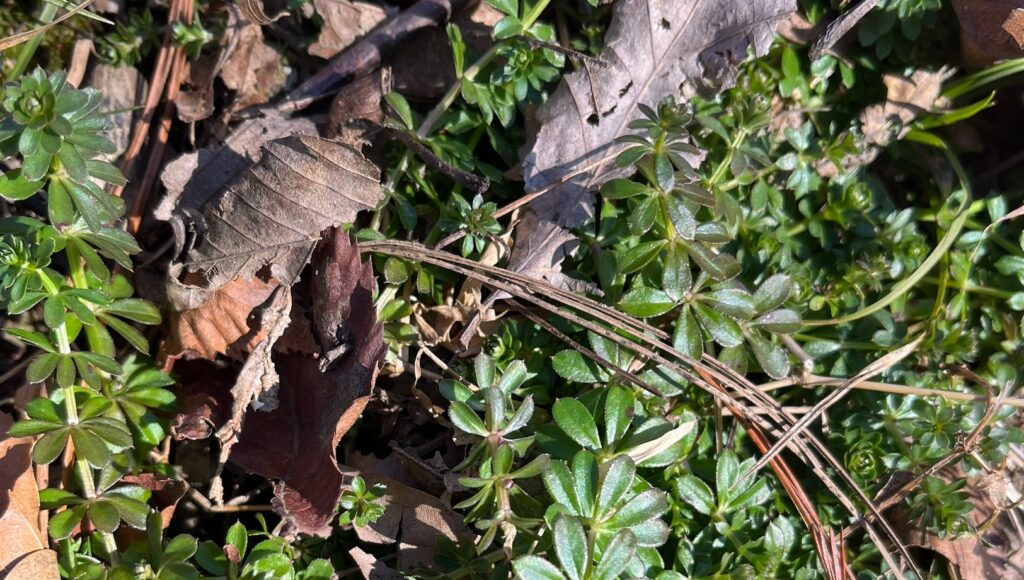Spring is a great time for replenishing, detoxifying and starting a new. As the early season flowers and herbs begin to rise again above the soil, taking nourishment in from the sun, we too can rise again by planting seeds through our well-intentioned actions or deeds. Here are three essential herbs to look out for as we transition into the warmer months.
Cleavers, Galium aparine
Species name aparine derives from the Greek aparo, “to seize”, for the plant’s tendency to stick on whoever passes or grows nearby.1 The herb likes to grow along water and acts as a diuretic to remove heavy metals and toxins out the body through urination. Hence, the name cleavers meaning to sever or break a chemical bond.
Cleavers promote tissue repair, eliminate fibroid tissue from the body and encourage lymph flow by reducing swollen glands. Conditions like tonsillitis, mumps, epstein-barr, children’s ear infections, fibrocystic breasts have been relieved with the use of Galium aparine. 2 The plant contains: vitamin C, calcium, niacin, silica, polyphenolic acids, coumarin, tannins.
The young spring cleaver greens can be eaten raw, cooked or turned into a juice or succus. To preserve the succus the fluid can be frozen in ice trays and then defrosted for future consumption. Topically, cleavers can be prepared as a compress, poultice or salve to treat burns, cancer, eczema, poison ivy, scars, spider bites, sunburn (Mars)
Contraindications include blood thinning and it’s recommended to avoid if taking blood thinners such as Coumadin. 3
Dandelion, Taraxacum officinale
Dandelion is more than a ‘useless weed’. The wonder plant’s bitter principle Lactupicrine serves as a major liver cleanser and toner just in time for the warmer weather and starting a new. The liver loves the bitter taste of Dandelion. Some other nutrients include tannin, inulin, carotene, vitamins A, B, C, D , iron, potassium and zinc. All parts of the planet are edible. This is a major food source for early spring pollinators.
The bitter leaves can be added to a salad, steamed or sautéed and made into a standard infusion of dried herb for tea. The flower tops can also be tossed in a salad or made into a nourishing tea or infused oil. The leaves increase HCL, pepsin and bile production which especially helps with fat digestion. (Schechter)
Dandelion root is classified as an alterative herb due to its effect on the liver and strengthening energy. (Tierra) (Schechter) It benefits liver functions such as internal environmental protection, filtering blood, production of enzymes for digestion, break down of excess estrogen, temporal headaches, and removing foreign, harmful substances.
The root stimulates milk flow (making it slightly bitter) for pregnant women, alleviates toxemias and morning sickness during pregnancy and is used for pregnant women with a low hematocrit. (Schechter)
This herb is a gift. The easily absorbed rich choline content helps is the formation of acetylcholine which is a nerve transmitter.
Nettle, Urtica dioica
Nettles are a major nutritive herb packed with beneficial minerals and vitamins. Some that we know of are iron, protein, vitamins B, C, E, K, flavonoids (quercitin, ruin, kaempferol), calcium, chromium, silica, tannin, chromium, silica, chlorophyll, albuminoids, amines (histamine, acetylcholine, serotonin, 5-hydroxyaliphatic acid), hydroxycoumarins, mucilage, saponins (lignin, sitosterol), glycosides.
For those who get spring allergies, Nettles are your ally. They improve the body’s resistance to pollens, molds, and environmental pollutants by stabilizing mast cell walls, which stops the hyperactive cycle of mucous membranes. (Mars) Nettles are used for arthritis, asthma, atherosclerosis, cellulite, headaches and much more.
This superfood can be cooked or dried and made into a tea. Cooking the nettle leaves will remove the sting. Try this delicious and nutritious Nettle Soup recipe this spring. When juiced nettles are a tonic beverage. They grow pretty much anywhere from roadsides to grasslands and moist woods.



